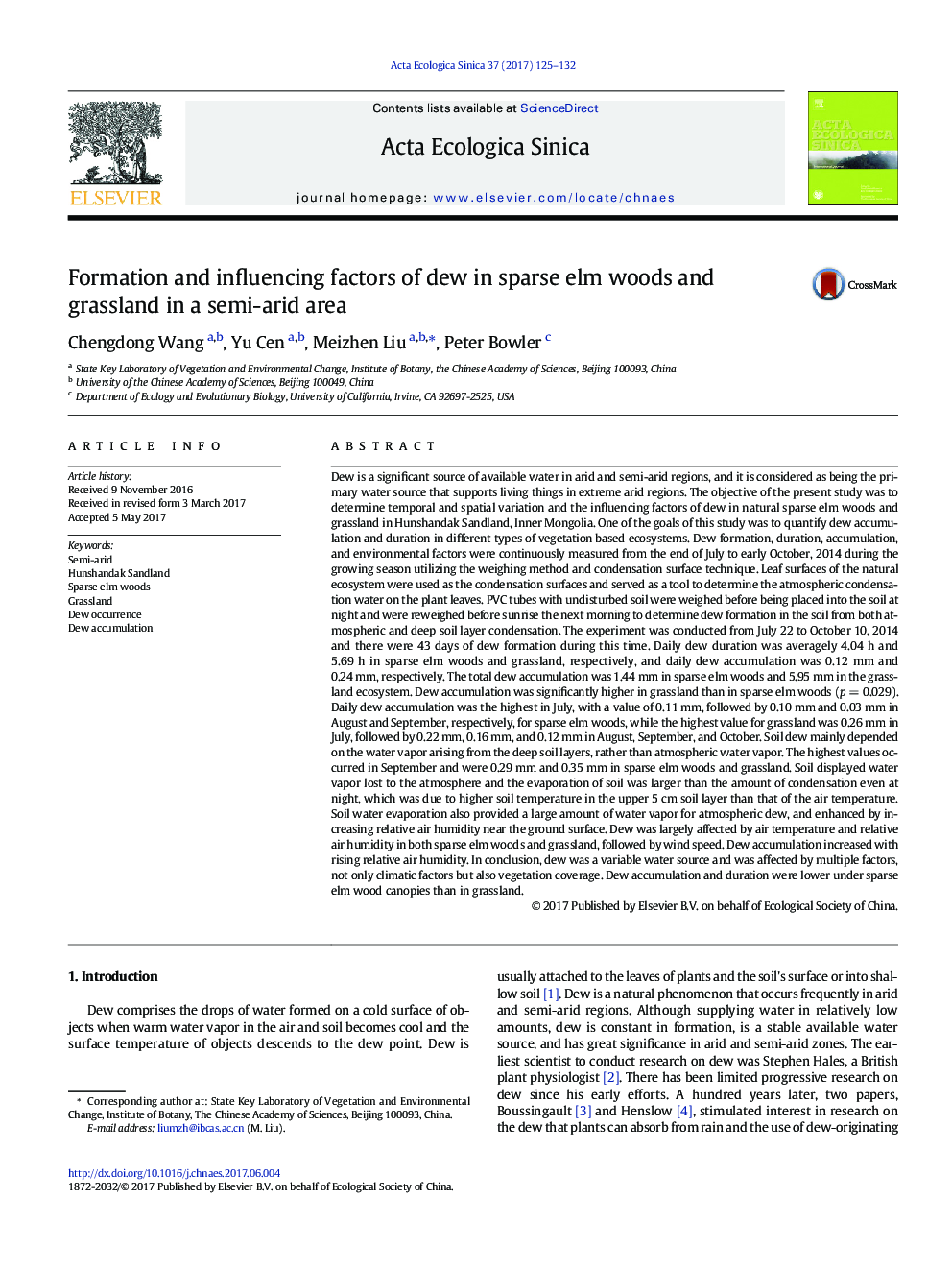| کد مقاله | کد نشریه | سال انتشار | مقاله انگلیسی | نسخه تمام متن |
|---|---|---|---|---|
| 8846370 | 1617674 | 2017 | 8 صفحه PDF | دانلود رایگان |
عنوان انگلیسی مقاله ISI
Formation and influencing factors of dew in sparse elm woods and grassland in a semi-arid area
ترجمه فارسی عنوان
شکل گیری و تأثیر عوامل گیاه گوزن در جنگل های درشت کمر و علف های هرز در یک منطقه نیمه خشک
دانلود مقاله + سفارش ترجمه
دانلود مقاله ISI انگلیسی
رایگان برای ایرانیان
کلمات کلیدی
نیمه خشک، هانس هانداک ساندلند، جنگل انجیر، چمنزار وقوع رخساره، تجمع دهان،
موضوعات مرتبط
علوم زیستی و بیوفناوری
علوم کشاورزی و بیولوژیک
بوم شناسی، تکامل، رفتار و سامانه شناسی
چکیده انگلیسی
Dew is a significant source of available water in arid and semi-arid regions, and it is considered as being the primary water source that supports living things in extreme arid regions. The objective of the present study was to determine temporal and spatial variation and the influencing factors of dew in natural sparse elm woods and grassland in Hunshandak Sandland, Inner Mongolia. One of the goals of this study was to quantify dew accumulation and duration in different types of vegetation based ecosystems. Dew formation, duration, accumulation, and environmental factors were continuously measured from the end of July to early October, 2014 during the growing season utilizing the weighing method and condensation surface technique. Leaf surfaces of the natural ecosystem were used as the condensation surfaces and served as a tool to determine the atmospheric condensation water on the plant leaves. PVC tubes with undisturbed soil were weighed before being placed into the soil at night and were reweighed before sunrise the next morning to determine dew formation in the soil from both atmospheric and deep soil layer condensation. The experiment was conducted from July 22 to October 10, 2014 and there were 43 days of dew formation during this time. Daily dew duration was averagely 4.04 h and 5.69 h in sparse elm woods and grassland, respectively, and daily dew accumulation was 0.12 mm and 0.24 mm, respectively. The total dew accumulation was 1.44 mm in sparse elm woods and 5.95 mm in the grassland ecosystem. Dew accumulation was significantly higher in grassland than in sparse elm woods (p = 0.029). Daily dew accumulation was the highest in July, with a value of 0.11 mm, followed by 0.10 mm and 0.03 mm in August and September, respectively, for sparse elm woods, while the highest value for grassland was 0.26 mm in July, followed by 0.22 mm, 0.16 mm, and 0.12 mm in August, September, and October. Soil dew mainly depended on the water vapor arising from the deep soil layers, rather than atmospheric water vapor. The highest values occurred in September and were 0.29 mm and 0.35 mm in sparse elm woods and grassland. Soil displayed water vapor lost to the atmosphere and the evaporation of soil was larger than the amount of condensation even at night, which was due to higher soil temperature in the upper 5 cm soil layer than that of the air temperature. Soil water evaporation also provided a large amount of water vapor for atmospheric dew, and enhanced by increasing relative air humidity near the ground surface. Dew was largely affected by air temperature and relative air humidity in both sparse elm woods and grassland, followed by wind speed. Dew accumulation increased with rising relative air humidity. In conclusion, dew was a variable water source and was affected by multiple factors, not only climatic factors but also vegetation coverage. Dew accumulation and duration were lower under sparse elm wood canopies than in grassland.
ناشر
Database: Elsevier - ScienceDirect (ساینس دایرکت)
Journal: Acta Ecologica Sinica - Volume 37, Issue 3, June 2017, Pages 125-132
Journal: Acta Ecologica Sinica - Volume 37, Issue 3, June 2017, Pages 125-132
نویسندگان
Chengdong Wang, Yu Cen, Meizhen Liu, Peter Bowler,
